2021 Ohvale GP-2 Review - First Ride

A slightly bigger minibike training tool for those beyond puberty
If you’ve been following the minimoto space, you’ve probably heard of the Ohvale name. The Italian company pumping out mini road racers has been a hot topic of conversation in trackday and racing circles. We all know that riding big bikes on a racetrack is a thrill unlike any other. But it’s also true that riding full-size sportbikes at trackdays can be pretty expensive – up the ante even more if you decide to go race. Beyond the cost of the bike itself, you’ve got trackday fees, fuel costs, and tire bills. The costs go up even more if you have to schlep it a long way from home and find lodging for a night or two.
Minimotos, and in this case Ohvale specifically, offer a much more affordable option while providing a lot of the same thrills as a big bike. Depending where you live, go-kart tracks are generally closer than big tracks, entry fees are tens of dollars rather than hundreds, tires last significantly longer, and it’s not uncommon to top off the gas tank at the start of the day and forget about it. All the while, the on-track experience mimics that of a sportbike – the dynamics and technique you use to go fast on a small bike all transfer over to the big ones, too.
This is the market Ohvale is tapping into thanks to Brandon Cretu, co-founder of Rise Moto, the US importer for Ohvale. He’s a former racer who’s competed at several prestigious events like the Isle of Man TT, Macau GP, 24 Hours Of LeMans, and the Suzuka 8-Hour, just to name a few. After seeing these little bikes ripping around kart tracks in Europe, he knew he had to spread the word in America.
Ohvale’s first offering, the GP0, comes in several shapes and sizes with 110cc, 160cc, and 190cc air-cooled Singles being the engine choices. All are carbureted, and all are available with four-speed gearboxes (there’s also a version of the 110 with an automatic gearbox). Surrounding the engine is a steel trellis frame, several different suspension options, and 10-inch wheels fitted with sticky slicks. In sticking with the miniature sportbike theme, Ohvale designers studied the geometry of modern sportbikes and replicated the sprocket positions, chain pull, trail and offset numbers to mimic the bigger bikes. They also replicated the 53%/47% front and rear weight distribution of those bikes, too.
A simple internet search for Ohvale will bring back numerous stories and videos of racers riding the wheels off these little bikes, sometimes embarrassing folks on bigger bikes in the process. What you won’t find is a review of the GP0 on Motorcycle.com. The reason? Well, the GP0 is small. A Honda Grom looks like a Gold Wing in comparison, and a lifetime of doing dumb things to my body means I just can’t contort myself onto a GP0 for anything more than a lap or two these days.
Enter the GP2
This preamble was necessary to frame what we have here: Ohvale’s next release, the GP2. A bigger minibike, that might sound a little silly at first, but Ohvale realized the GP0’s tiny dimensions put off a lot of adults, or even those whose bodies have made it past puberty. With the GP2, Ohvale has retained the essence – and the engine – from the GP0 and harnessed it in a package that’s slightly more comfortable for the average adult. If only just.
Visually, the small and (slightly) less small bikes look nearly identical, but going beyond the bodywork (which has also been changed a little) will show how the GP2 grew. First and foremost, the steel trellis frame is longer, with 0.5º more steering angle. At the other end, the swingarm is 25mm longer too. As a result, the GP2 grows in length to 63.4 inches (1610 mm) from 57.9 inches (1470 mm).
To fit larger riders, the actual user interface had to grow, too. By that, we mean the seat itself grew in length to allow a full-size human to move around and not fall off the back. Seat height is a short 28.5 inches from the ground, but by definition this isn’t a bike anyone will have a problem reaching the ground on. At the front, the handlebar angle position is adjustable via slots within the triple clamp, MotoGP style. In keeping with the GP-bike-stuck-in-the-dryer theme, the third point of the ergonomic triangle, the pegs, are equally as thought out as the bars. Various threaded mounting holes within the tab on the frame lets you put the rearsets in a number of different positions, practically guaranteeing adequate peg placement for anyone’s boot size. All in all, once my 5-foot, 8-inch frame was seated on it, I felt, dare I say it, comfortable.
The other big change for the GP2 compared to the GP0 is the bigger 12-inch wheels. Not only does the bigger wheel/tire combo “fill out” the bigger profile of the bike, but it also adds a little more stability compared to the 10-inch wheels on the GP0. As an added bonus, 12-inch tire selection is also in your favor, as more mainstream manufacturers are starting to recognize the burgeoning minimoto scene.
Odds, Ends, and Available Options
What separates Ohvales from, say, a converted kid’s dirtbike fitted with 12-inch wheels is the fact that Ohvales are designed from the start for a specific purpose: mini roadracing. Converting a dirtbike inherently brings with it compromises. Another example of the GP2’s roadracing bias is seen at the front end. The triple clamps are wide enough, and space the fork tubes far enough, to be able to remove the front wheel without having to remove the brake caliper. And speaking of brakes, you’ll find a J.Juan four-piston caliper, radially mounted, grabbing a 220 mm disc. That’s full-on sportbike componentry shrunken down to minibike proportions. You also get steel-braided brake lines, too.
As for the suspension, standard GP2s get a 33mm inverted fork with spring preload the only thing you can adjust. However, you can upgrade to a 38mm fork from Mupo, complete with rebound, compression, and spring preload adjustments. Out back is a fully adjustable shock.
Pretty standard stuff. But here’s where the parallels with bigger sportbikes really takes off – accessories and options. A quick thumb through the Ohvale catalog reveals things like Öhlins shock, different springs, an EVR slipper clutch, various front and rear sprockets, a reverse-shift gear lever, lever guards, tire warmers, stands, and even an Alfano GPS-enabled dashboard all available as options. These are the same kinds of upgrades anyone would do on their big bike.
Riding Impressions
Right, so what’s the GP2 like to ride? In one word: a blast. Ok, that’s two words, but the parallels between it and full-size sportbikes are amazing. There is a small learning curve, however, and that’s getting on and starting the horizontal little Single. Unlike a big bike, you kickstart a GP2 and fiddle with a choke lever. Give it some gas as you kick and watch it (or rather hear it) fire it to life.
Oddities like the kill switch being reversed (clicking down instead of up turns off the ignition) and neutral being all the way up – our test bikes were fitted with the reverse shift gear lever – instead of between first and second get learned quickly, and once you sit on it things start to feel familiar – just smaller.
This theme would continue throughout the day. On track, the word I kept coming back to after every lap was familiar. The Daytona 190 engine is a little gem, made awesome by its simplicity and power. Air-cooled, with a single camshaft and four valves, Ohvale doesn’t say how much power it makes, but a stroll through the internet has shown these little engines pumping out 20 horses to the wheel. Not bad considering the whole thing weighs 156 pounds (dry).
With so little weight and a healthy 20 horses eager to tear up Pirelli’s new 12-inch Diablo Rosso SC scooter tires, the GP2 feels anything but slow. Clicking first and heading onto the track, the power is just there. This may be a little bike, but its bite can match its bark. Those 20 horses are pushing you along at an exciting pace and you need to keep pace with all four gears to get the most out of the bike.
Despite the GP2’s dimensions, reaching the shifter never felt cramped. In fact, it felt rather normal. There’s no quickshifter here, so upshifting quickly means rolling off the throttle for a flash as your toe clicks another gear. The GP2 demands a deliberate click and perfect timing with your throttle hand, otherwise it’ll stay in its current gear. However, considering the bikes we rode had never been ridden before, I’m hoping shifts get easier as the bike breaks-in some more. The four gears get the job done, but it’d be nice to have a fifth cog to choose, since the 190 engine loses steam the closer it gets to redline and I found myself looking for a fifth gear that wasn’t there.
The real beauty of the GP2, and Ohvales in general, comes when you try to piece the straights with the corners. Maximizing momentum, understanding chassis dynamics, and learning how placing your body weight affects it are all heightened on the GP2 in ways we take for granted on bigger bikes.
You attack corners the same way you do on bigger bikes, using the brakes to load the front while hanging off the bike as you determine your line choice. You need to be careful getting back on the gas, too, as going wide open when you’re fully leaned over can spell a recipe for disaster.
By now you’re getting the idea that riding this little bike is just like riding something bigger, and it’s true. Each movement you make, control you touch, and sensation you feel all make the GP2 a great training tool for budding road racers or those who want to pretend to be one. Being such a little thing, dragging an elbow on the ground has never been more approachable – if that’s your thing, of course. The part I wasn’t expecting was how much communication the Ohvale gives you, especially when things aren’t going right.
For example, being that the bikes we rode were basically uncrated, fueled up, and thrown onto the racetrack meant there was zero time to prep the suspension and geometry settings. So, even though the sensation of speed and acceleration felt familiar, all the riders who rode the GP2, myself included, all felt an unstable feeling from the front end, as if there wasn’t enough trail to keep the bike planted while leaned over.
As Cretu later pointed out to me, it’s common to adjust the forks on the GP0 so the caps are flush with the triple clamps. Doing so on these pre-production GP2s raised the front end about 6mm, and while that may not sound like much (it actually is), the difference on track was night-and-day. The twitchiness from the front was gone, replaced with confidence and stability. Had we had more time to tweak the bike more, the possibilities to go faster were definitely there.
Things I didn’t like? Sure, but they’re pretty minor. First are the brakes. They work well enough. However, the initial bite isn’t very strong, and you find yourself squeezing them harder than you think you should. At least they’re consistent lap after lap, allowing the rider to adjust. Our particular test bikes weren’t fitted with the slipper clutch, and while it may not be absolutely necessary, the quicker you get, the quicker you’ll find yourself banging off downshifts in rapid succession. It’s then you realize how much easier a slipper clutch will make things.
Lastly, there’s the ergonomics. The bigger bike is just the thing for riders like myself who couldn’t cram themselves onto the GP0 for very long for whatever reason. It’s surprising how much room you have to move side to side, and even more surprising that footpeg clearance isn’t an issue, either. Despite this, it’s still hard to fully get into a tuck. Moving back in the saddle, my butt reached the end of the seat quickly, and if I really wanted to tuck in I’d be firmly on top of the slim tail section… and possibly beyond that. If you’re even taller, forget it.
The Hype Is Real
Going on a riff about a bike like this giving you limited space is a little pointless, isn’t it? You should know that going in. However, the bigger dimensions of the GP2 matter where it counts – and that’s opening the doors to minimoto training to a much wider swath of potential riders put off by the tiny dimensions of the original GP0. This is what’s cool about the GP2. Having similar riding dynamics as a big bike isn’t so surprising, but having similar communication from the chassis, then being able to tune the bike just as you would anything else brings with it obvious lessons and experience that are invaluable for anyone looking to improve their track skills, especially youngsters coming up through the ranks.
Of course, having a cool training tool like this comes at a price. Starting at $6,499, that doesn’t include the Mupo suspension, Alfano dashboard, reverse shift lever, and other odds and ends our test bikes were fitted with (those prices are still TBD as of press time). Whether or not that’s a steep price to pay depends on how seriously you take minimoto training, but if you’ve read this far then clearly the GP2 strikes a chord with you. There’s a reason why several top-level racers practice on minibikes from Ohvale, and if it’s good enough for them then it’s gotta be good enough for you, right?
2021 Ohvale GP2
+ Highs
- A minibike the average adult can fit on!
- All the same riding dynamics as a big bike
- A cool training tool for road racers
– Sighs
- Getting one might be a steep proposal for some
- Brakes lack a little bite
- Still not much room for a full tuck
2021 Ohvale GP2 Specifications | |
|---|---|
| MSRP | $6,499 |
| Engine Type | 187.2cc, four-stroke, air-cooled horizontal single-cylinder, SOHC, four valves per cylinder |
| Bore and Stroke | 62mm x 62mm |
| Fuel System | Keihin PE28 or Dell’Orto PHBH 28 |
| Ignition | Electronic, external spark plug and coil |
| Starter | Kick starter with decompression system |
| Exhaust System | Stainless steel exhaust pipe with underseat Arrow titanium silencer |
| Lubrication | Wet sump, oil quantity: 1 liter |
| Transmission | 4 speed N-1-2-3-4 |
| Final Drive | Chain |
| Front Suspension | 33mm inverted fork with spring preload adjustability (optional 38mm inverted fork with CNC foot and preload, rebound, and compression damping |
| Rear Suspension | Aluminum swingarm, monoshock with piggyback reservoir, adjustable for compression, rebound, and spring preload |
| Front Brake | Single radial-mounted four-piston caliper with 220mm disc |
| Rear Brake | Single-piston caliper with 180mm disc |
| Front Tire | 100/90-12 |
| Rear Tire | 120/80-12 |
| Frame | Tubular steel trellis |
| Max length/width/height | 63.4 in./29.1 in. (at the handlebars)/36.0 in |
| Seat Height | 28.5 in. |
| Dry Weight (Claimed) | 156.5 lbs. |
| Fuel Capacity | 0.92 gallon (3.5 liters) |
| Colors | Black/yellow, white/red, blue/orange, grey/orange |
In Gear
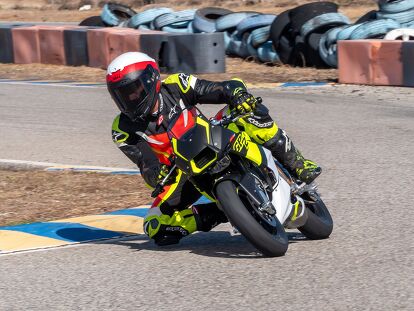
- Helmet: Bell Race Star Flex $592
- Suit: Alpinestars GP Tech v3 Race Suit For Tech Air Race $1999.95
- Gloves: Alpinestars GP Pro R3 $259.95
Boots: Alpinestars Limited Edition Crutchlow Supertech-R Boots $500.00

Troy's been riding motorcycles and writing about them since 2006, getting his start at Rider Magazine. From there, he moved to Sport Rider Magazine before finally landing at Motorcycle.com in 2011. A lifelong gearhead who didn't fully immerse himself in motorcycles until his teenage years, Troy's interests have always been in technology, performance, and going fast. Naturally, racing was the perfect avenue to combine all three. Troy has been racing nearly as long as he's been riding and has competed at the AMA national level. He's also won multiple club races throughout the country, culminating in a Utah Sport Bike Association championship in 2011. He has been invited as a guest instructor for the Yamaha Champions Riding School, and when he's not out riding, he's either wrenching on bikes or watching MotoGP.
More by Troy Siahaan



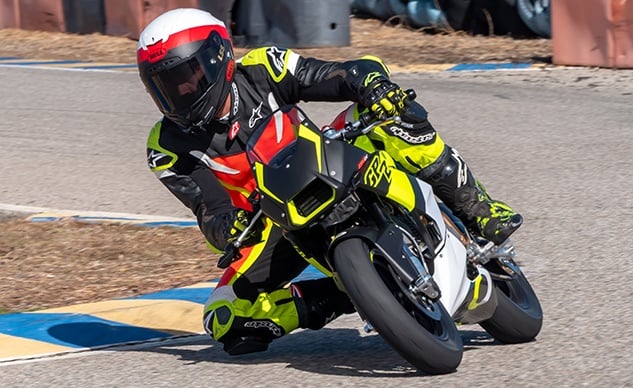































































































































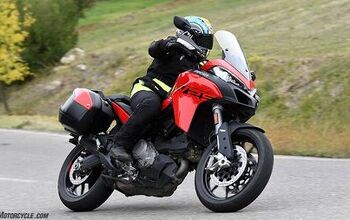

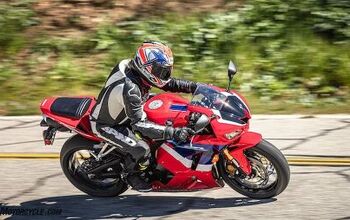
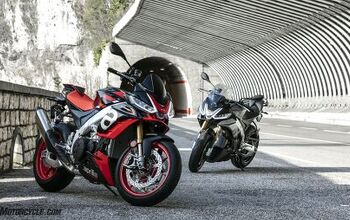



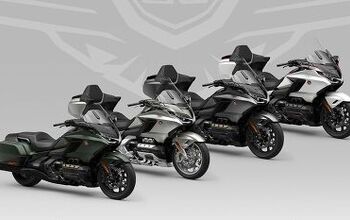







Comments
Join the conversation
I so wish I had a kart track close to me. This looks like the most fun you can have on asphalt!
So now I know what I look like on a sportbike, if I was only so slim...